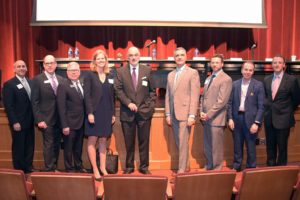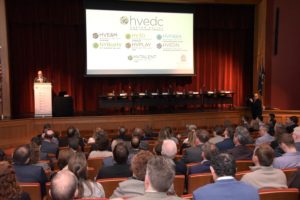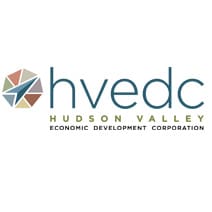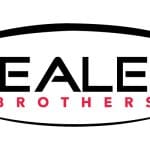Region’s future commercial real estate scene will be marked by advancements in technology and a rapidly changing business environment
GOSHEN, N.Y. (April 13, 2018) — Hudson Valley Economic Development Corporation President and CEO Laurence P. Gottlieb, along with Richard Haggerty, CEO of the Hudson Valley Gateway Association of Realtors, co-moderated an enlightening panel today at Hudson Valley Visionaries: A Look Into the Future of Commercial Real Estate. More than 400 guests attended the panel, which took place inside the Nelly Goletti Theatre at Marist College in Poughkeepsie.

The panel of experts from the Hudson Valley incorporated their thoughts of the future into a lively discussion with the audience about the commercial real estate market and the industry as a whole. They discussed trends that have been observed across the United States and are beginning to happen in the Hudson Valley, such as a growing use of new technologies, design features and functions.
“The Hudson Valley is experiencing an era of unprecedented economic growth,” said Gottlieb. “Development projects continue throughout the region while economic indicators point upward. Even then, it is only a matter of time before the regional commercial real estate market begins to follow the trends that have been observed across the United States as a whole.”
Some developers are renewing old shopping malls and corporate parks into stunning new mixed-use developments. Creators of industrial space are anticipating major impacts from new technologies such as autonomous vehicles and the use of robotics in warehousing. These sorts of ongoing technological evolutions are opening up brand new markets and industries with a significant amount of future potential, while also changing the way developers design and construct commercial space.
For example, many commercial real estate developers across the nation are beginning to change the way they approach the creation of Class A office space. Today’s development firms are looking at ways they can leverage existing spaces to create high-quality, sustainable office environments that better fit with tenants’ workflow and employees’ needs.
“Based on trends we’re seeing in commercial real estate, the office buildings of tomorrow may include a diversity of mixed-use components, like pop-up restaurants or transformational spaces,” Gottlieb said. “The new incoming crop of office buildings will feature pervasive technological integration and condominium-style amenities, like yoga centers and catering kitchens.”
The panel was made up of the most widely known experts in the industry:
- Seth Pinsky, Executive VP, Fund Manager, Metro Emerging Markets & Public Affairs Director, RXR Realty
- Robert Weisz, CEO, RPW Group
- Tim Smith,Regional Vice President, Crown Castle Fiber
- Sara Jones-Maturo, President, RM Friedland
- Luiz Aragon, Development Commissioner, City of New Rochelle
- Anthony Gioffre III, Partner and Chair of Land Use, Zoning & Development Group, Cuddy & Feder LLP
- Frank Cuevas, VP, Real Estate Strategy & Operations, IBM
“Companies are locating where they can find the best talent,” said Weisz, opening the discussion with a statement that would be a recurring theme on the day: The demands of the modern workforce are driving some key industry trends.
The panel agreed that today’s employees, particularly millennials, are looking for an experiential “live/work/play” model, which Jones-Maturo characterized as communities in transit-oriented areas where employees can live, work and eat all within a square block. Weisz also pointed out the significant shift this represents from the days when corporate offices were often located near the homes of company executives.
The panel also addressed the make-up of the modern office building, from the obvious necessity for them to be tech-laden, to the enhanced amenities employees are looking for. Properties need to have open spaces for collaborative and efficient work. Locations must be able support high density work stations.

“Enclosed spaces are not things that will be workable in the future,” said Cuevas.
Office buildings must also provide access to enhanced amenities like unique on-site dining, recreation and fitness areas, all of which deliver on the live/work/play experience and increase employee retention. All of this was tied to the role tech has played in eroding the concept of the eight-hour work day.
“Gone are the days of a one-hour lunch break,” said Jones-Maturo. “These people come in at nine [a.m.], work until eight [p.m.] and never leave the building.”
Pinsky added that to grow and maintain a talent base, one of the best ways to attract that talent is to make your jurisdiction attractive to them.
Aragon shared success stories about how the City of New Rochelle has attracted commercial development, prompting discussion on the role that municipalities can play in luring and facilitating development projects, which is to adopt a model that provides a simplified path to site approvals, with minimal bureaucracy.
Additional topics addressed the increased demand for warehousing capacity as online retail continues to disrupt how people shop. At the same time, Jones-Maturo pointed out that experiential retail remains a growing segment of the market, encompassing things like boutique fitness studios and salons. The panel also tackled the topic of leases trending toward the short-term, and best practices for activating brick and mortar retail locations.
The overarching message of the presentation was one of embracing change.
“Everything changes and the process we are going thru now is a very positive one because it is addressing quality of life,” said Weisz. “That goes for the places we live to the places we work.”
Summing up the statements of the day into a call to action, co-moderator Haggerty closed with this: “We need to take all the best ideas we have an act on them. We need to act; we need to adapt. Change is happening quickly, and we can’t afford to wait forever.”
About Hudson Valley Economic Development Corporation (HVEDC):
HVEDC is the leading economic development agency for the seven-county region of Westchester, Putnam, Dutchess, Rockland, Orange, Ulster and Sullivan counties. The public-private partnership markets the region as a prime business location to corporate executives, site selection consultants and real estate brokers. HVEDC helped start the organizational, branding and promotional effort for NY BioHud Valley, Hudson Valley 3D Printing, Hudson Valley EDs & MEDs and the Hudson Valley Food & Beverage Alliance. To learn more, call 845-220-2244 or visit hvedc.com.




